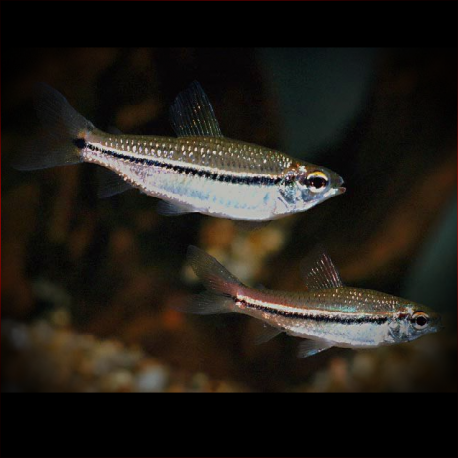More info
Datasheet
| Minimum Tank Size | 55 litres / 14.53 US gallons |
| Maximum Size | 6.5cm / 2.56inches |
| Temperature | 22°C / 71.60°F - 26°C / 78.80°F |
| Hardness | 5-12ºdH |
| pH | 6.5-7.5 |
Behaviour:
The One-Lined African Characin is a timid species that prefers to be kept in a shoal, feeling more secure in the presence of its own kind. Despite its shyness, it can coexist peacefully in a community tank with other small, non-aggressive species, making it a suitable choice for a mixed aquarium setup.
Aquarium Setup:
For optimal well-being, the One-Lined African Characin thrives in a well-planted aquarium with subdued lighting. The tank should ideally be densely planted, with plants that grow up to the surface and some floating species to soften the light. Subdued lighting or dim lighting is recommended over bright, harsh lighting. Driftwood, smooth rocks, and additional decor can be included to mimic a natural habitat and provide hiding spots for this shy species to feel secure.
Feeding and Diet:
In the wild, the One-Lined African Characin is an opportunistic omnivore, feeding on small invertebrates, algae, and zooplankton. While they may initially refuse dried foods, most live and frozen food options are readily accepted. Offering a varied diet that includes live and frozen foods is essential for their overall health and nutrition in an aquarium setting.
Reproduction & Dimorphism:
Breeding One-Lined African Characins in captivity is uncommon. When breeding is attempted, a small breeding tank with soft, acidic water, along with the addition of java moss or spawning mops, is recommended. Males, which are smaller and more brightly colored, will exhibit deep red coloration in the dorsal and upper caudal fins during spawning. The females are typically larger and less vibrantly colored than the males.
Habitat and Distribution:
Found in various regions including Cameroon, Nigeria, and the Republic of Congo, the One-Lined African Characin inhabits streams, small rivers, lakes, and ponds in these areas. It has been documented in river systems such as the Congo, Niger, and Cross rivers. While there are reports of a Ghanaian population, its existence is currently uncertain.

